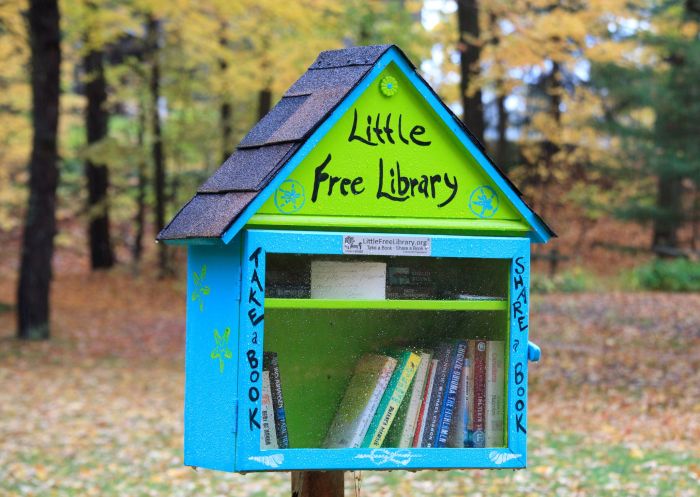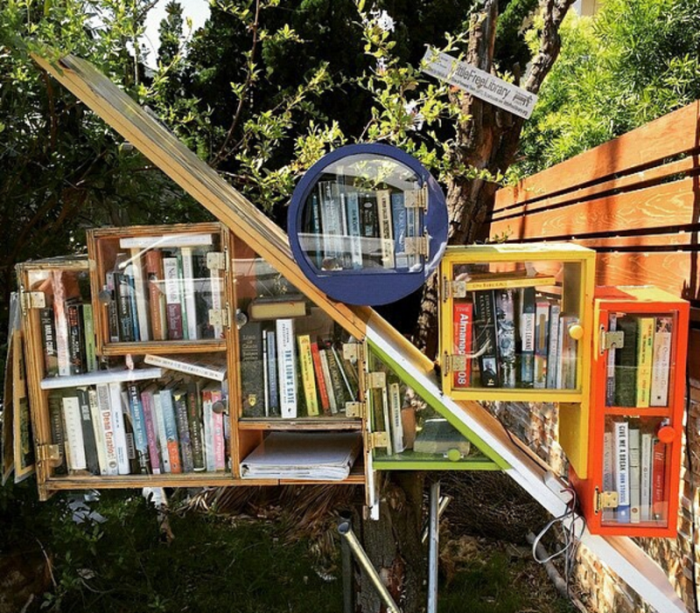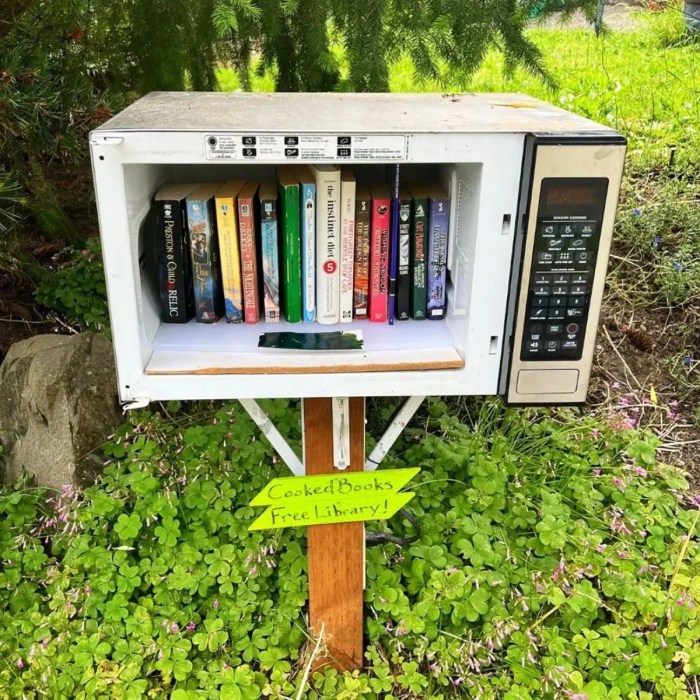Diy little free library – DIY Little Free Libraries are a testament to the power of community and the enduring love of reading. These charming, self-serve book exchanges have become a ubiquitous sight in neighborhoods worldwide, offering a unique way to share stories, foster literacy, and connect with neighbors.
The concept is simple: build a small, accessible structure, stock it with books, and let the community do the rest. Whether it’s a whimsical birdhouse, a charming wooden box, or a repurposed mailbox, the DIY aspect allows for endless creativity and personalization. Little Free Libraries have blossomed into a global phenomenon, proving that even the smallest act of kindness can have a profound impact.
The Rise of DIY Little Free Libraries
The Little Free Library movement has blossomed into a global phenomenon, with thousands of these miniature book-sharing stations popping up in neighborhoods around the world. These charming, often hand-crafted structures represent a powerful testament to the enduring power of community and the joy of sharing books.
Origins and History
The concept of Little Free Libraries traces its roots back to 2009 when Todd Bol, a Wisconsin man, built a miniature library in honor of his mother, who was an avid reader. Bol’s simple act of kindness quickly caught on, and soon, others were building their own Little Free Libraries, sharing books with their neighbors and fostering a love of reading in their communities.
Community-Driven Nature
Little Free Libraries are fundamentally community-driven initiatives. They are built, maintained, and stocked by volunteers who are passionate about sharing books and promoting literacy. The libraries operate on a simple principle: “Take a book, leave a book.” This system encourages a sense of shared ownership and responsibility, fostering a sense of community among neighbors.
Examples of Successful DIY Little Free Libraries
- The “Book Nook” in Seattle, Washington: This Little Free Library, built by a local artist, is a vibrant and whimsical structure that has become a beloved landmark in the neighborhood. The Book Nook features a whimsical design, with colorful mosaics and a charming little door. The library is regularly stocked with a diverse selection of books for all ages, attracting readers from all walks of life.
- The “Little Free Library on Wheels” in New York City: This innovative library is housed in a repurposed bicycle trailer, allowing its owner to bring books to different parts of the city. The library is a popular destination for children and adults alike, offering a unique and mobile way to access books.
- The “Little Free Library in a Treehouse” in California: This whimsical library is located in a treehouse in a residential neighborhood. The treehouse library is a popular spot for children to read and play, providing a magical and immersive reading experience.
Building Your Own Little Free Library

Ready to share your love of books with your community? Building your own Little Free Library is a fun and rewarding project. You can create a unique and beautiful structure that reflects your personal style while providing a valuable resource for your neighborhood.
Choosing the Right Materials and Tools
Selecting the right materials and tools is crucial for building a sturdy and long-lasting Little Free Library. The materials you choose will affect the style, durability, and cost of your library.
- Wood: Wood is a popular choice for Little Free Libraries due to its versatility, affordability, and ease of working with. Consider using weather-resistant woods like cedar, redwood, or pressure-treated lumber for increased longevity.
- Plastic: For a more durable and low-maintenance option, consider using plastic materials like recycled plastic lumber or even repurposed containers.
- Metal: Metal can be used for specific elements like hinges, doors, or decorative accents. However, it requires specialized tools and techniques.
In addition to the materials, you’ll need a basic set of tools for construction, including:
- Saw: A circular saw or a hand saw for cutting wood.
- Drill: For drilling holes for hinges, screws, and other fasteners.
- Screwdriver: For attaching the various components.
- Measuring tape: For accurate measurements.
- Level: To ensure the library is level and stable.
- Safety gear: Always wear safety glasses, gloves, and a dust mask when working with power tools and wood.
Designing Your Little Free Library
The design of your Little Free Library is entirely up to you! You can find inspiration from existing libraries, online resources, or even create your own unique design.
Here are some design ideas to get you started:
- Classic Bookcase Style: A traditional bookcase design with shelves and a door for easy access.
- Birdhouse Design: A charming and whimsical design that resembles a birdhouse.
- Mailbox Design: A simple and practical design that resembles a mailbox.
- Custom Designs: Let your creativity run wild and design a unique library that reflects your personal style.
Consider the following factors when designing your library:
- Size and Scale: The size of your library should be appropriate for the space where it will be located.
- Accessibility: Ensure the library is accessible to people of all ages and abilities.
- Durability: Choose materials and construction methods that will withstand the elements.
- Aesthetics: Consider the overall look and feel of the library and how it will blend in with its surroundings.
Building a Basic Little Free Library
Once you have chosen your materials and design, you can start building your library. Here is a step-by-step guide for building a basic Little Free Library:
- Cut the wood: Cut the wood to the desired dimensions using a saw.
- Assemble the frame: Assemble the frame of the library using screws or nails.
- Add the shelves: Attach the shelves to the frame.
- Install the door: Install the door using hinges and a latch.
- Paint or stain: Paint or stain the library to protect it from the elements and give it a finished look.
- Add a roof: If desired, add a roof to protect the books from rain.
- Install a sign: Add a sign to identify the library as a Little Free Library.
Remember to follow all safety precautions when using power tools and working with wood.
Building a DIY Little Free Library is a great way to share your love of books with your community. It’s a simple project that can be customized to fit your style. You might even be inspired by some of the creative DIY projects that are out there, like building your own DIY mobile home skirting. Just remember, whether you’re building a library or skirting, a little bit of creativity and effort can go a long way.
Choosing the Perfect Location: Diy Little Free Library

The location of your Little Free Library is crucial for its success. You want to choose a spot that’s easily accessible, visible, and attracts a steady stream of visitors.
Factors to Consider When Choosing a Location
A good location for your Little Free Library will consider several factors, including:
- Foot Traffic: The ideal location is one with high foot traffic, such as a busy street corner, park, or community center. This ensures that people will see your library and have the opportunity to borrow or donate books.
- Visibility: Ensure your library is visible from the street or sidewalk. Consider placing it in a well-lit area or using bright colors to attract attention.
- Accessibility: Your library should be easily accessible to people of all ages and abilities. This means choosing a location with a level surface, adequate lighting, and clear signage.
- Safety: Choose a location that is safe and secure. Avoid placing your library in an area with high crime rates or poor lighting.
- Community Support: Consider whether the location has the support of local businesses or community organizations. This can help you with maintenance and promotion.
Benefits of Placing Your Library in a High-Traffic Area
Placing your Little Free Library in a high-traffic area offers numerous benefits:
- Increased Visibility: High-traffic areas naturally attract more attention, increasing the chances of people noticing your library.
- Higher Book Turnover: With more people passing by, you’ll likely experience a higher turnover of books, ensuring a fresh selection for visitors.
- Greater Community Engagement: A bustling location fosters a sense of community and encourages more people to participate in sharing and borrowing books.
- Enhanced Public Awareness: A high-traffic location increases the library’s visibility and helps raise awareness about the Little Free Library movement.
Tips for Ensuring Your Library is Accessible and Visible
- Use Bright Colors: Paint your library in vibrant colors to attract attention and make it stand out from its surroundings.
- Install Clear Signage: Place clear and informative signage near the library, indicating its purpose and how to use it.
- Ensure Adequate Lighting: Make sure your library is well-lit, especially during evenings and nighttime hours, to ensure safety and visibility.
- Consider a Raised Platform: If your location has a lot of foot traffic, consider placing the library on a raised platform to make it more visible and accessible.
- Decorate with Eye-Catching Elements: Add decorative elements like colorful flowers, wind chimes, or artwork to attract attention and create a welcoming atmosphere.
Stocking Your Library with Books

A well-stocked Little Free Library is a joy to behold. It invites readers of all ages and interests to discover new worlds within its humble shelves. But the key to a thriving library lies in selecting a diverse range of books that appeal to a wide audience.
Creating a Diverse Collection
A diverse collection ensures that every visitor finds something they enjoy. Consider including books from different genres, cultures, and time periods. This creates a welcoming environment for everyone, encouraging them to explore new perspectives and broaden their horizons.
- Fiction: Offer a variety of genres, including classics, contemporary novels, science fiction, fantasy, romance, mystery, and thrillers.
- Nonfiction: Include biographies, memoirs, history books, science books, self-help guides, and cookbooks.
- Children’s Books: Cater to young readers with picture books, chapter books, and graphic novels.
- Multilingual Books: If your community is diverse, consider adding books in different languages.
Creating Themed Collections
Themed collections can add a unique touch to your library. This approach can be a fun way to engage visitors and introduce them to specific topics or authors.
- Local Authors: Showcase the works of writers from your community.
- Historical Fiction: Gather books set in a specific historical period.
- Science Fiction: Feature books that explore the future and outer space.
- Mystery and Crime: Create a collection of thrilling and suspenseful reads.
Acquiring Books, Diy little free library
There are several ways to acquire books for your Little Free Library.
- Donations: Encourage people to donate books they no longer need. You can post flyers, announce your needs on social media, or set up a donation box at your library.
- Book Swaps: Host a book swap event where people can exchange books with others.
- Local Libraries: Contact your local library to see if they have any books they are willing to donate.
- Thrift Stores: Thrift stores often have a wide selection of books at affordable prices.
“The more books you read, the more things you will know, the more things you will know, the more places you’ll go.” – Dr. Seuss
Building a DIY Little Free Library is a rewarding endeavor that brings joy to both the builder and the community. By providing access to books, fostering a love of reading, and encouraging social interaction, these small libraries create a sense of connection and belonging. So, grab your tools, choose your design, and get ready to build a little free library that will become a cherished landmark in your neighborhood.
